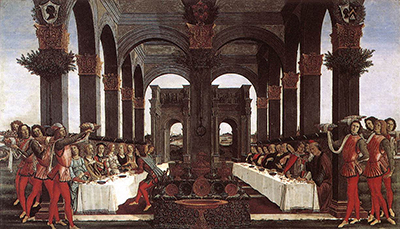Nastagio degli Onesti is a character created by Giovanni Boccaccio who would inspire four different artworks by Sandro Botticelli. They were produced as part of a single project, but have since been separated and are now displayed in different European countries.
This panel was titled Marriage of Nastagio degli Onesti (Story of Nastagio Degli Onesti) and one can immediately identify the scene, with tables stretching into the distance. Unlike other panels from this series such as Nastagio Meets the Woman and the Knight in the Pine Forest of Ravenna and The Banquet in the Forest, there is a relative calm to be found here, without any figures arriving on horseback to cause panic. The painting found here has a more carefully crafted perspective, aided by the tables which are angled in order to create this depth. There are also supporting structures which create arches on both sides of the painting and these continue this feeling of perspective as the background and foreground fuse together. Nearest us are several falconers with birds as well as some musicians which presumably was typical of the type of entertainment that would have been found at weddings during this period in Italian history. Within the very centre of the painting we find items of furniture which were prepared to enable the formalities of the day to be carried out.
The main point to note about this panel is how the artist really displays his handling of architecture. Previous to the Renaissance, architecture was not really depicted accurately and was often flattened in an unrealistic manner. Marriage of Nastagio degli Onesti can now be found within the permanent collection of the Palazzo Pucci in Florence, with the other panels now displayed elsewhere. The paintings were commissioned for a wedding gift to be given to Giannozzo Pucci and Lucrezia Bini. Botticelli's services were called upon several times for items such as these and he was known to have a subtle, delicate approach to art that would be highly suitable. Florentine art was also highly respected at this time and had become embedded in culture and high society, with the biggest names being treated almost like celebrities as their reputations started to soar. This meant assistants would be required as new commissions continued to arrive fairly frequently.
It would take the influence of British artists such as John Everett Millais, Dante Gabriel Rossetti and William Holman Hunt to restore the reputation of Sandro Botticelli in the 19th century. For many years he had actually been forgotten in favour of other members of the Renaissance but this would be changed after attempts to have his work re-appraised. Today this seems somewhat bizarre, as some of his paintings, such as The Birth of Venus and Primavera, are considered by many to be some of the most iconic contributions to the entire Italian Renaissance. Most can instantly recognise these artworks, even if they cannot actually identify the source right away and it is pleasing to see this highly skilled painter restored to the high status that he certainly deserves after leaving behind such as influential body of work.




